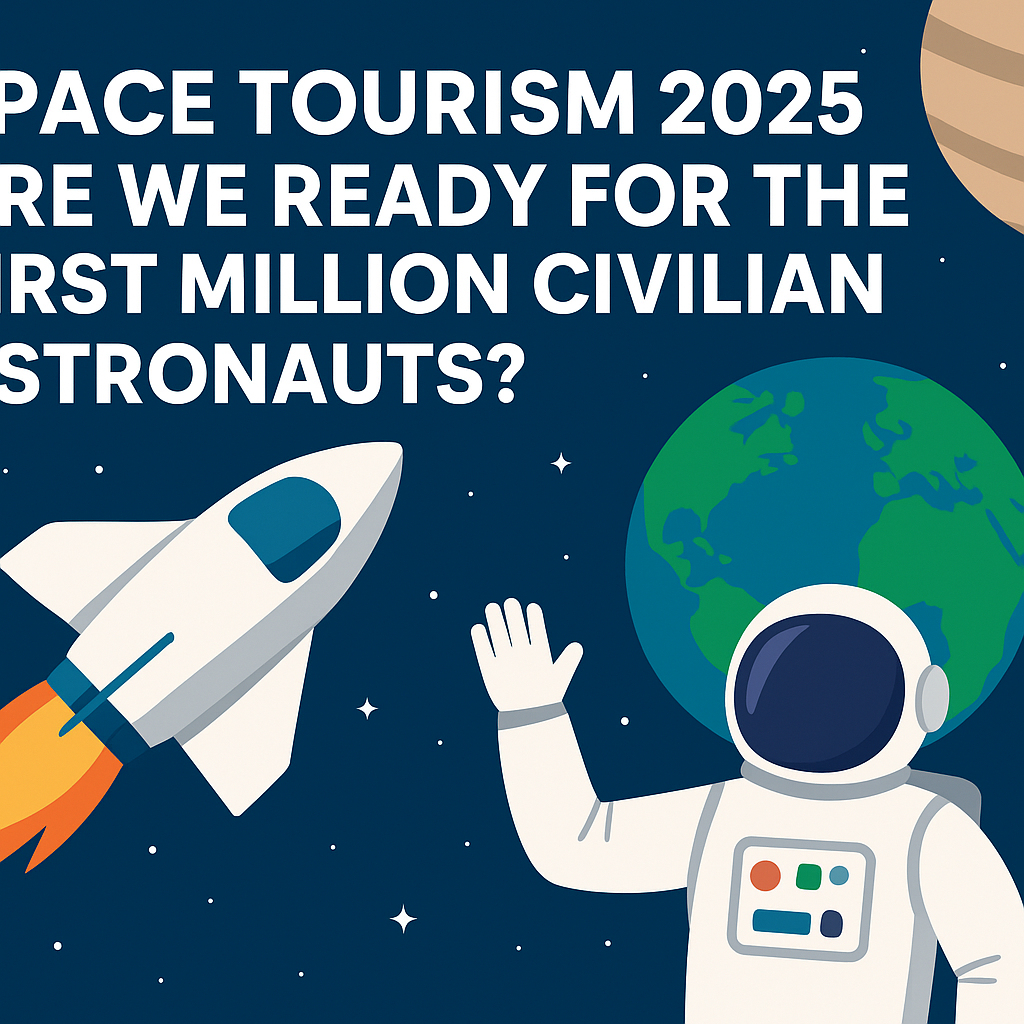Introduction: From Sci-Fi to Reality
For decades, the idea of civilians traveling into space seemed like a distant dream confined to the pages of science fiction or Hollywood movies. Yet, in 2025, space tourism is no longer just a billionaire’s fantasy—it’s becoming a genuine, growing industry. Companies like SpaceX, Blue Origin, and Virgin Galactic have already carried paying passengers beyond Earth’s atmosphere, and hundreds more flights are planned in the coming years. The key question now is: are we truly ready to scale from dozens of tourists to potentially one million civilian astronauts in the next two decades?
The Current State of Space Tourism in 2025
SpaceX: Commercial Flights to Orbit and Beyond
SpaceX’s Starship program has been pivotal in transforming space travel. In 2025, Starship is capable of launching private citizens into orbit for multi-day experiences aboard the craft. The company has even announced plans for a lunar flyby mission with tourists, scheduled for late 2026.
Unlike earlier suborbital flights, which lasted just minutes, SpaceX offers something closer to a true astronaut experience—complete with microgravity, Earth views from orbit, and extended stays.
Blue Origin: Suborbital Adventures
Jeff Bezos’ Blue Origin continues to operate New Shepard, a suborbital rocket carrying six passengers to the edge of space. Flights last around 10 minutes, providing a brief but breathtaking view of Earth’s curvature.
While less ambitious than SpaceX, Blue Origin’s flights are more frequent and relatively affordable compared to orbital missions.
Virgin Galactic: Luxury Tourism in the Skies
Virgin Galactic has leaned into the luxury tourism market, branding its flights as a once-in-a-lifetime experience. In 2025, the company operates routine trips from Spaceport America in New Mexico, with a waiting list of thousands.
The brand appeals not only to thrill-seekers but also to influencers, celebrities, and even scientific researchers looking for quick access to microgravity.
Ticket Costs: Who Can Actually Afford Space Travel?
While prices are gradually falling, space tourism is still far from mainstream.
-
Blue Origin & Virgin Galactic: ~$250,000 to $450,000 per seat.
-
SpaceX Starship missions: Several million dollars per seat (though group bookings reduce costs).
-
Future projections: Analysts predict ticket prices could drop below $100,000 by 2035—still expensive, but comparable to luxury world cruises.
For now, the vast majority of Americans cannot afford it. Space tourism remains a privilege for the ultra-wealthy, though companies insist prices will drop as technology scales.
Civilian Astronaut Training: Preparing for the Journey
Unlike professional astronauts who undergo years of NASA-level training, civilian space tourists only receive a few days to weeks of preparation.
-
Blue Origin provides one-day training sessions, covering safety and basic procedures.
-
Virgin Galactic offers several days of preparation, including microgravity simulations.
-
SpaceX requires more rigorous training (weeks to months), especially for orbital missions.
While shorter training lowers barriers, critics argue that space tourists may not be ready for emergencies—especially during orbital or lunar missions.
The Economic Ripple Effect
Space tourism is more than just rocket rides—it’s an emerging trillion-dollar industry with ripple effects across multiple sectors.
-
Jobs: Engineers, technicians, trainers, hospitality staff at spaceports.
-
Tourism: Spaceport-adjacent cities (like New Mexico and Texas) see increased hotel, dining, and entertainment revenue.
-
Innovation: Advances in reusable rockets and lightweight materials benefit other industries like aviation and logistics.
-
Space infrastructure: The push for private space stations is accelerating as companies prepare to host space tourists in orbital hotels.
Legal, Ethical, and Safety Concerns
Regulation: Who Governs Space Tourism?
Currently, the FAA (Federal Aviation Administration) regulates U.S.-based launches, but international coordination remains weak. Questions remain:
-
Who is responsible if a civilian dies in orbit?
-
What happens if space debris causes accidents?
-
Can private companies claim property rights in orbit?
Ethics: Luxury or Waste?
Critics argue space tourism is a playground for billionaires while Earth faces pressing challenges like climate change and poverty. Proponents counter that innovations in space travel will trickle down to everyday industries, much like aviation did.
Safety: Not Without Risks
While no fatalities have occurred during commercial flights yet, space travel remains inherently dangerous. Rocket launches involve extreme forces, and even minor malfunctions can be catastrophic.
The Future: Toward One Million Civilian Astronauts
Is one million space tourists by 2045 realistic? Analysts suggest:
-
By 2030: Tens of thousands of cumulative tourists.
-
By 2035: Hundreds of thousands, as ticket costs decline and more companies enter the market.
-
By 2045: Possibly over a million people will have experienced space, if safety, affordability, and demand align.
Companies like Orbital Assembly are already designing space hotels—giant rotating structures that simulate gravity. By the 2030s, these could host hundreds of tourists per year, accelerating the industry’s growth.
Conclusion: Standing at the Edge of a New Era
In 2025, space tourism is at a crossroads. The dream is no longer science fiction—it’s happening. Yet, accessibility, safety, and regulation remain hurdles before space becomes a vacation destination for the average American family.
Still, if current trends continue, our children may grow up viewing a trip to orbit the way we view a flight to Paris: expensive, yes—but not unthinkable. The first million civilian astronauts are on the horizon. The question is: will you be one of them?
